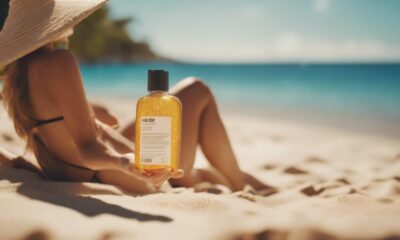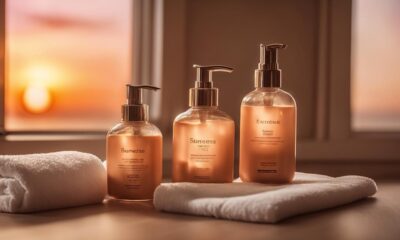Tanned Skin
Natural Tanning Methods: Get a Sun-Kissed Look Without Chemicals
Master natural tanning methods for a sun-kissed glow without chemicals, and discover the secret tips for maintaining your radiant look!

Natural tanning methods let you get a gorgeous, sun-kissed glow without harsh chemicals. You can whip up homemade self-tanners using organic ingredients like black tea and vanilla extract, which not only smell great but are also good for your skin. Exfoliate and moisturize before application for a smooth finish. Remember to apply in layers and use a mitt for even coverage. To maintain your tan, hydrate daily and reapply every 5-7 days. With these tips, you'll achieve a healthy, radiant look. Stick around, and you'll find even more insights on mastering your natural tanning routine.
Key Takeaways
- Utilize DIY self-tanners made from organic ingredients like black tea and vanilla for a natural, chemical-free tan.
- Exfoliate and moisturize your skin 24 hours before application for an even and radiant finish.
- Enhance your skin tone from within by consuming foods rich in beta-carotene, such as carrots and sweet potatoes.
- Apply self-tanner using a mitt or brush in circular motions for a streak-free application, layering for desired depth.
Healthier Alternatives to Commercial Tanners
If you're looking for healthier alternatives to commercial tanners, consider trying DIY self-tanner recipes that use organic ingredients like black tea and vanilla extract. These natural tanning methods not only give you a sun-kissed glow without harsh chemicals, but they also promote skin health.
Unlike many commercial options that contain synthetic fragrances, these non-toxic self-tanners deliver pleasant scents that make the application process enjoyable.
Incorporating foods rich in beta-carotene, such as carrots and sweet potatoes, can enhance your skin tone from the inside out, providing a holistic approach to tanning. To achieve the best results, make certain to exfoliate your skin before applying your DIY self-tanner. This step guarantees an even application, preventing any streaking or patchiness often seen with conventional products.
Additionally, many organic self-tanner recipes include nourishing ingredients like aloe vera and coconut oil, which support skin hydration and overall health. By choosing these chemical-free options, you're not only opting for a more natural look but also caring for your skin in the process.
Embrace these healthier alternatives and enjoy a beautiful, radiant tan.
Homemade Self Tanner Recipes
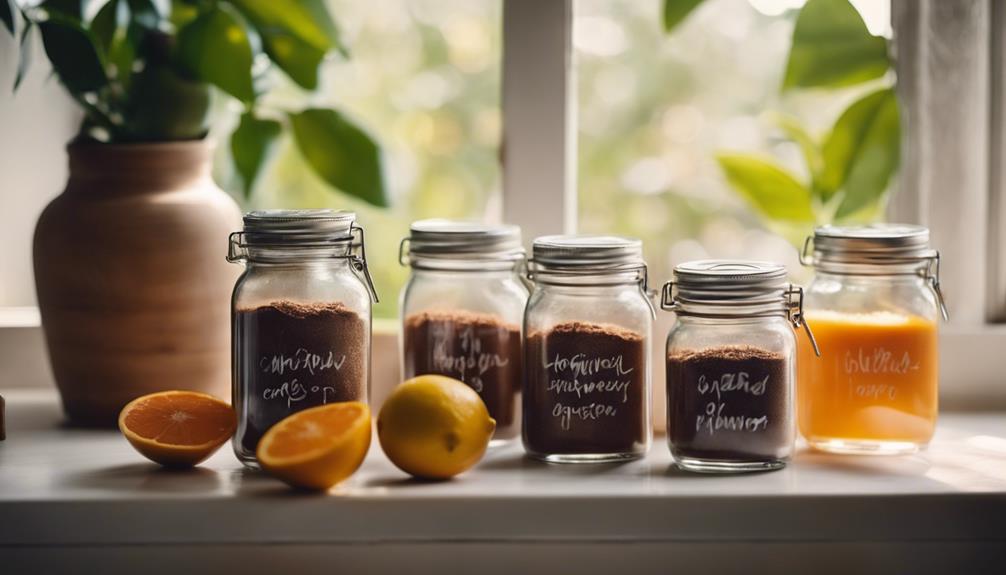
When you're looking to achieve a sun-kissed glow, homemade self-tanner recipes can be a game changer.
You'll find that simple ingredients like organic black tea and vanilla extract create an effective solution.
Plus, mastering the application techniques can guarantee a smooth and even tan, making your DIY experience even more rewarding.
Simple Ingredients Needed
Creating a natural homemade self-tanner requires just a few simple ingredients you likely already have at home. For a quick and effective recipe, all you need is 8 bags of organic black tea and 16 oz. of filtered water. The addition of 1 tablespoon of vanilla extract not only enhances the scent but also contributes to the overall experience, making it a delightful, chemical-free option.
To prepare your self-tanner, start by boiling the water. Once it's bubbling, add the vanilla extract and then steep the tea bags for at least 8 minutes. This will allow the natural ingredients to infuse, creating a rich solution that gives you a beautiful, sun-kissed glow. After steeping, let the mixture cool before applying it to your skin.
This DIY self-tanner provides a lovely tan that can last for several days without the unpleasant odors often associated with commercial products. Just remember to test it on a small area first, especially if you have sensitive skin. With these simple ingredients, you can achieve a radiant, natural look safely and effectively.
Application Techniques Explained
To achieve the best results with your homemade self-tanner, start by exfoliating your skin thoroughly to guarantee an even application. This step removes dead skin cells, ensuring a smoother canvas for your tanning solution.
For your DIY self-tanner, steep 8 bags of organic black tea in 16 oz. of filtered water with 1 tablespoon of vanilla extract, then allow it to cool.
Before applying the homemade self-tanner, moisturize your skin, particularly in drier areas like elbows and knees. This helps prevent uneven absorption of the tanning solution.
Apply the tanner using your hands or a mitt in circular motions, which allows you to blend well and cover all areas evenly, helping you achieve that desired natural-looking tan.
After application, let the tanner dry completely before dressing. It's wise to test the tanner on a small patch of clothing first to avoid potential staining.
Application Tips for Best Results
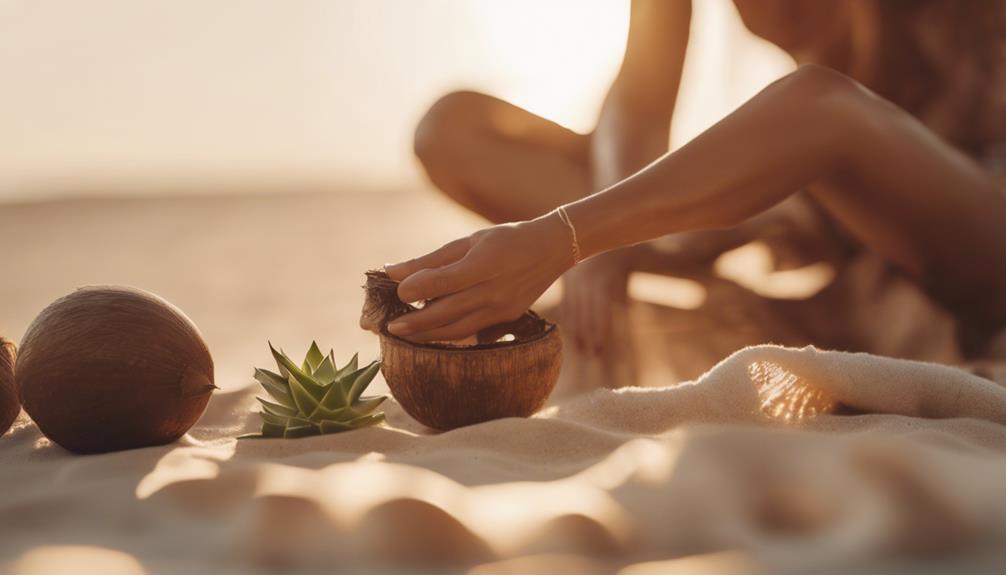
Exfoliating your skin before application guarantees a smooth surface, allowing the tanner to adhere evenly for the best results. Use a gentle scrub or an exfoliating mitt to remove dead skin cells. This step is essential for achieving that coveted brown glow without uneven patches.
After exfoliating, focus on moisturizing dry areas like your elbows, knees, and ankles with an oil-free lotion. This prevents these spots from absorbing too much self-tanner, ensuring even coverage.
When applying the self-tanner, use a mitt or Kabuki brush, and work in circular motions for a streak-free finish. Make sure to let each layer dry completely before dressing to avoid transfer onto your clothes. If you desire a deeper color, consider layering the tanner. Just remember to allow each layer to dry fully before adding more product, adjusting based on your skin type and desired shade.
Before going all-in, test the self-tanner on a small patch of skin to check for adverse reactions, especially if you have sensitive skin or are trying a new formulation with natural ingredients.
Follow these application tips, and you'll enjoy a beautiful, sun-kissed look.
Maintaining Your Tan's Longevity

Keeping your tan looking fresh and vibrant requires daily hydration and careful maintenance. To achieve this, you should moisturize your skin every day, using products rich in hydrating ingredients like ceramides. This not only helps maintain color but also enhances tan retention, keeping your sun-kissed glow longer.
Reapplying self-tanner every 5-7 days is essential to sustain an even appearance without overdoing it. Pay attention to areas that may experience uneven fading, such as elbows and knees, and focus on moisturizing these drier spots to prevent patchiness.
Additionally, limit hot showers and opt for mild soaps to protect your tan from fading prematurely. Hot water can strip your skin's moisture, leading to quicker color loss, while gentle cleansers help maintain your glow.
When it comes to exfoliation, remember that harsh scrubs can damage your tan; instead, use gentle exfoliation methods to avoid buildup while preserving your color.
Community Experiences and Insights

You've probably heard some amazing personal success stories from others experimenting with natural tanning methods.
As you navigate your own journey, you might also face challenges that many in the community can relate to.
Sharing effective tips can help you and others achieve that sun-kissed glow safely and naturally.
Personal Success Stories
Many community members have discovered the joy of using DIY self-tanners, sharing their success stories about achieving a natural glow without harsh chemicals. By experimenting with natural self-tanners, like an organic black tea recipe, you can enjoy a sun-kissed glow while avoiding the unpleasant smells of commercial products. Many users report positive experiences, noting that consistent application leads to a beautiful, natural appearance.
Exfoliation and moisturizing before application are essential steps that enhance your results. These practices guarantee an even application and help the tan last longer, making your effort worthwhile. Redheads and those with sensitive skin have particularly praised the effectiveness of these chemical-free tanning alternatives, finding them gentle and irritation-free.
Community members encourage embracing your natural skin tones, and the supportive environment fosters creativity in DIY tanners. By sharing tips and tricks, you can learn from others about the best natural ingredients to use.
Challenges Faced Together
Steering the journey to achieve a natural tan without harsh chemicals can be intimidating, but community members share their insights and experiences to support one another through the challenges.
Many individuals, especially those with sensitive skin, often turn to DIY self-tanning solutions to create a sun-kissed glow. You might find that organic black tea is a popular choice among redheads, as it minimizes irritation while providing a lovely tint.
Proper skin preparation is essential, and community feedback emphasizes the importance of exfoliation and moisturizing. These steps help guarantee an even application of your chosen natural tanning products.
You may also appreciate the effectiveness and pleasant aromas of homemade tanners when compared to commercial options, which can cause rashes and unpleasant smells.
As you navigate your journey, remember that embracing natural skin tones is encouraged within this supportive community. Many members advocate for low-tox tanning methods, fostering acceptance and understanding of diverse beauty standards.
Sharing Effective Tips
Sharing experiences within the community opens up a wealth of effective tips for achieving that perfect natural tan without the drawbacks of harsh chemicals. Many have found success with DIY self-tanner recipes, like one made from organic black tea and vanilla extract, which offers a beautiful glow and a delightful scent.
Here are some key tips to remember:
| Tip | Description | Benefit |
|---|---|---|
| Exfoliate the skin | Remove dead skin cells before tanning | Guarantees even application |
| Use moisturizers | Apply to dry areas like elbows and knees | Promotes consistent color |
| Experiment with layering | Apply tanner in layers to control depth of color | Achieve your ideal sun-kissed look |
Before trying new self-tanner recipes, test them on a small area to avoid allergic reactions. Many community members have achieved stunning results using these natural tanning methods, steering clear of chemical alternatives. By following these effective tips, you can enjoy a radiant, sun-kissed look while keeping your skin healthy and glowing.
Recommended Natural Tanning Products
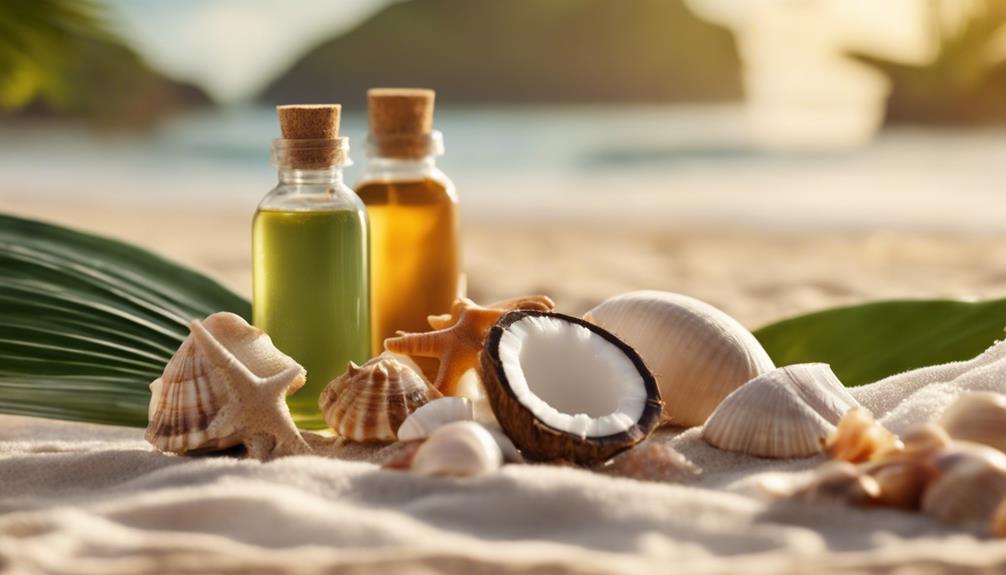
Explore a selection of highly-rated natural tanning products that not only enhance your glow but also prioritize skin health.
If you're looking for a self-tanner that works for sensitive skin, check out Whish's hydrating self-tanner, which combines organic ingredients for a streak-free tan and delightful coconut milk scent.
For those with fair skin, Kora Organics offers a gradual tanning lotion made with sugar-derived DHA, certified organic and pleasantly aromatic.
Isle of Paradise presents color-correcting tanning drops that allow you to customize your tan easily by mixing them with your skincare routine. This cruelty-free and hypoallergenic option is perfect for achieving a personalized glow.
Alternatively, Beauty by Earth's vegan self-tanner is highly rated for its ability to cover skin imperfections, utilizing natural ingredients like shea butter to guarantee it's a safe alternative to chemical tanners.
Finally, Vita Liberata's invisible foaming water self-tanner dries quickly, contains natural extracts, and delivers a natural-looking tan within 4-8 hours, all without staining your skin.
With these products, achieving a sun-kissed look has never been easier or healthier!
Essential Preparations for Tanning
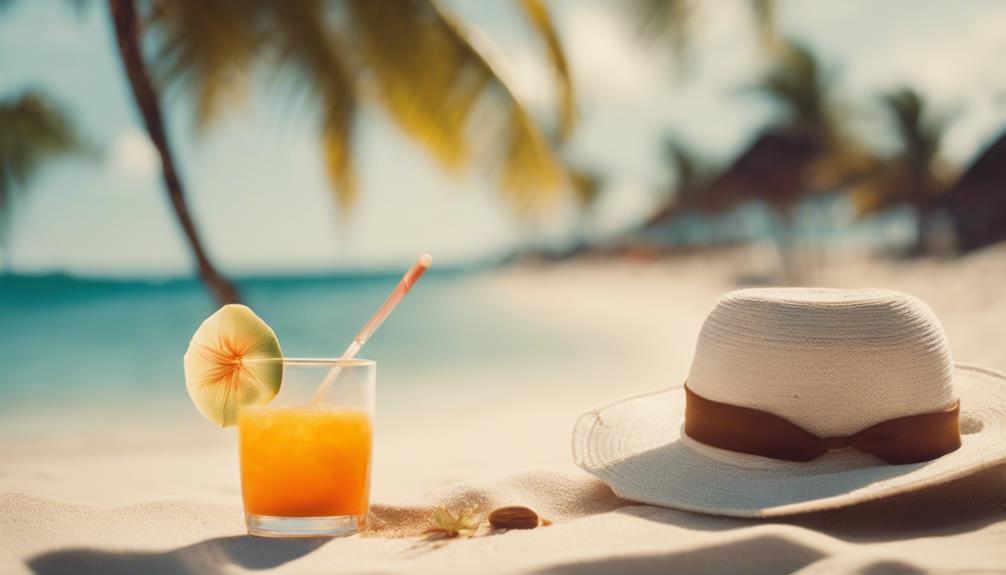
Preparing your skin properly before tanning is vital for achieving a flawless, sun-kissed glow. Start by exfoliating beforehand to guarantee that dead skin cells are removed. This step is critical for a smooth application of self-tanning products and will help you achieve an even application.
Here's a quick guide to important preparations:
| Preparation Step | Key Tips |
|---|---|
| Exfoliate | Remove dead skin cells 24 hours prior. |
| Moisturize | Use oil-free moisturizers on drier areas like elbows and knees. |
| Shaving/Waxing | Complete this at least 24 hours before tanning. |
| Patch Test | Always test new self-tanning products for allergic reactions. |
Allow any pre-tanning moisturizers to fully absorb into your skin to avoid dilution of the tanning product. This guarantees ideal results, allowing your skin to soak in the color evenly. Taking these steps will set you up for a beautiful, natural tan that lasts longer and looks radiant.
Frequently Asked Questions
How to Get Naturally Tanned Skin Without Sun?
To achieve naturally tanned skin without the sun, exfoliate first, then apply a DIY self-tanner like brewed black tea. Hydrate well, layer for depth, and eat foods rich in beta-carotene for enhanced results.
How to Look More Tanned Naturally?
To look more tanned naturally, incorporate beta-carotene-rich foods into your diet, exfoliate regularly, and gradually increase sun exposure. Daily moisturizing helps maintain your glow, ensuring a smooth and radiant skin tone over time.
What's the Best Natural Looking Tan?
To achieve a beautiful, bronzed look, consider using gradual tanning lotions or DIY self-tanners made with natural ingredients. Exfoliating and moisturizing beforehand will guarantee your tan appears smooth, even, and effortlessly radiant.
How to Make Your Legs Look Tanned Without Fake Tan?
To make your legs look tanned without fake tan, exfoliate regularly, apply a homemade self-tanner like brewed black tea, hydrate with lotion, and use bronzing powders for an instant sun-kissed effect that complements your skin tone.
Can Natural Tanning Methods Benefit Men’s Skincare Routine?
Natural tanning methods can certainly benefit men’s skincare routine when incorporated into the best nighttime skincare routine men. Tanning outdoors can provide vitamin D, which is essential for healthy skin. However, it’s important to practice sun safety and use sunscreen to protect the skin from harmful UV rays.
Conclusion
Incorporating natural tanning methods can transform your look while keeping your skin healthy.
Did you know that over 90% of people prefer sunless tanning options due to the risks associated with UV exposure?
By opting for homemade tanners and following our tips, you'll achieve that sun-kissed glow without the harmful chemicals.
Plus, with a little care, you can maintain your tan longer.
So, embrace these natural alternatives and enjoy a radiant complexion safely!
Tanned Skin
Unlock Your Perfect Glow With Tanning Tips
Just follow these essential tanning tips to unveil your perfect glow and discover the secrets that will keep you glowing all season long!

Revealing your perfect glow is as easy as pie! First, know your skin type—fair folks should start slow with short sessions, while those with darker skin can go longer. Keep it safe by limiting your visits based on your type: fair skin, just one or two times a week, while medium can handle two to three. Don't forget to hydrate and moisturize before and after tanning, and always wear those stylish protective eyewear! Rotate your position for an even tan, and remember, glowing takes patience. Stick around, and you'll uncover even more fab tips to achieve that sun-kissed look you crave!
Key Takeaways
- Determine your skin type using the Fitzpatrick Scale to tailor your tanning sessions for optimal results.
- Start with short sessions and gradually increase duration to build a safe, even tan without burns.
- Stay hydrated and moisturize your skin before and after tanning to maintain its health and glow.
- Rotate positions during tanning sessions to achieve an even tan and minimize the risk of tan lines.
Understanding Your Skin Type
To achieve a beautiful tan, it's crucial to understand your skin type and how it affects your tanning sessions. You can use the Fitzpatrick Scale to figure out where you fall.
If you've got fair skin, start with short sessions, or you might end up looking like a lobster! Darker skin types can handle longer sessions, but safety's still key.
Remember, it's all about building that base tan gradually – 3 to 5 sessions usually show some color change.
Before you hit the tanning salon, make sure to hydrate, exfoliate, and ditch the makeup. Protective eyewear is a must, too!
Knowing your skin type sets the stage for a glowing, healthy tan, so let's get that perfect glow safely!
Managing Tanning Sessions
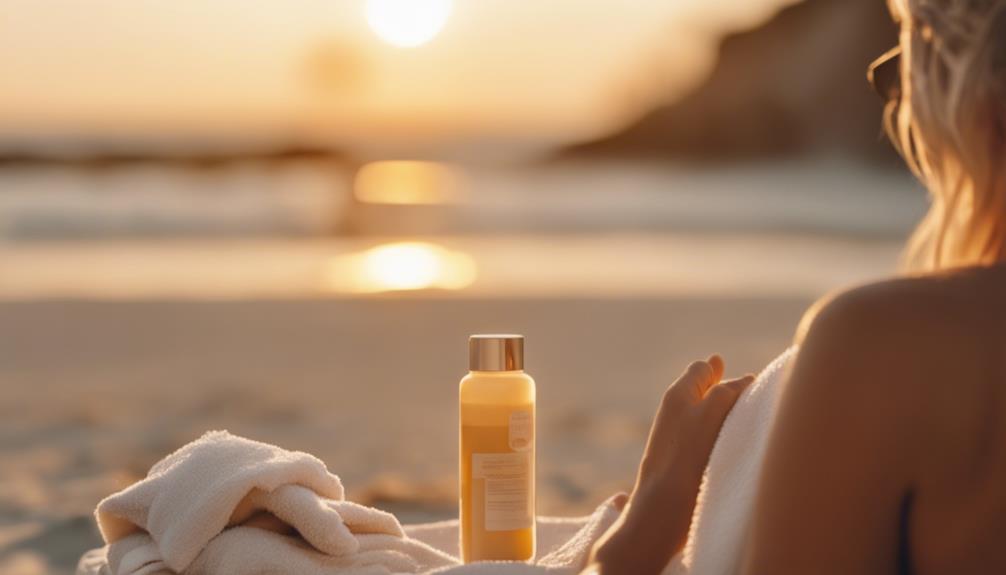
Knowing your skin type helps you plan your tanning sessions effectively, ensuring you maximize results while prioritizing skin health.
Start with shorter sessions, gradually increasing exposure, and remember to limit yourself to one session per day.
Here's a quick guide to how often you should tan based on your skin type:
- Fair: 1-2 times weekly
- Medium: 2-3 times weekly
Keep an eye on how your skin reacts, and don't hesitate to ask experts for personalized advice.
It's all about finding that perfect glow without turning into a lobster!
Practicing Responsible Tanning

How can you enjoy the benefits of tanning while minimizing skin damage?
First, start slow! Gradually build up your tanning sessions, and never go for more than one session a day.
You'll want to hydrate your skin like a thirsty plant—apply moisturizer and drink plenty of water. Trust me, your skin will thank you!
Avoid those tempting multiple sessions in one day; it's a one-way ticket to sunburn city! Instead, aim for a healthy glow without risking your skin health.
Remember, a little preparation goes a long way. Keep an eye on how your skin reacts, and don't hesitate to ask tanning experts for their best advice.
With these tips, you'll be on your way to a gorgeous tan and happy skin!
Techniques for Even Tanning

Building on responsible tanning practices, achieving an even tan requires attention to your positioning and skin hydration during sessions. You don't want to end up looking like a zebra, right? Here are some tips to help you achieve that gorgeous glow:
- Rotate your position: Move around during sessions to avoid those pesky tan lines.
- Stay hydrated: Drink plenty of water and use a good moisturizer to keep your skin looking fresh and even.
With these techniques, you'll be on your way to a stunning, even tan that'll make you the envy of the beach! Enjoy the sunshine!
Exploring Additional Resources
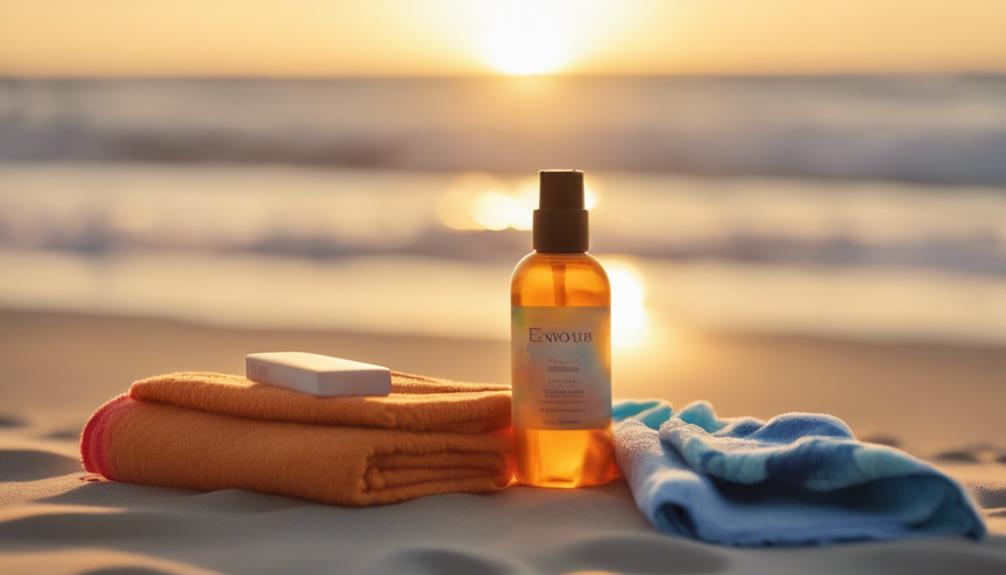
Discovering additional resources can elevate your tanning experience and help you achieve that perfect glow safely and effectively. Tanning isn't just about hitting the beds; it's about knowing what to do before, during, and after your sessions! Check out this handy table to guide your journey:
| Resource Type | What It Offers | Where to Find It |
|---|---|---|
| Tanning Guides | Tips on frequency and safety | Tanning salon websites |
| Skin Care Products | Moisturizers and tan extenders | Beauty supply stores |
| Online Forums | Community advice and experiences | Social media platforms |
Frequently Asked Questions
How Long Does a Tan Typically Last Before Fading?
A tan typically lasts about 5 to 10 days before fading, depending on your skin type and care. To prolong it, keep your skin moisturized and avoid exfoliating too often. Regular hydration helps too.
Can I Tan if I Have Sensitive Skin?
Like a delicate flower needing gentle sunlight, you can tan with sensitive skin, but start slowly. Prioritize short sessions, hydration, and consult professionals to find the best approach for your unique skin needs.
What Are the Best Products for Post-Tan Care?
For post-tan care, use moisturizers rich in aloe vera or vitamin E to hydrate your skin. Avoid harsh soaps and hot water, and don't forget to drink plenty of water to maintain skin health.
Is It Safe to Tan While on Medication?
If you're on antibiotics, like Sarah was, tanning can increase sun sensitivity and risk skin reactions. Always consult your doctor before tanning while on medication to guarantee your skin stays healthy and safe.
How Can I Prevent Sunburn While Tanning?
To prevent sunburn while tanning, always apply a broad-spectrum sunscreen, limit your exposure time, and gradually build your tan. Stay hydrated and wear protective clothing when necessary to shield your skin effectively.
Conclusion
So, there you have it! With these tanning tips, you're all set to glow like a superstar—just remember, you're aiming for sun-kissed, not lobster-red!
By knowing your skin type and managing your sessions responsibly, you can enjoy that radiant look while keeping your skin happy.
Who knew getting that perfect tan could feel so much like a science experiment?
Now, go out there, soak up some sun, and embrace your fabulous glow with a smile!
Tanned Skin
Optimize Your Tan: Space Out Sessions
Become a tanning pro by learning how spacing out your sessions can enhance your glow—discover the secrets to a stunning tan!

If you wanna rock that sun-kissed glow and keep your skin healthy, spacing out your tanning sessions is key! Start with short sessions, around 5-10 minutes, and make sure to wait 48 hours before your next one. This gives your skin time to recover and build up melanin, which helps you get a deeper tan without the burn. Plus, staying hydrated is super important, so drink plenty of water and eat your fruits and veggies! Trust me, moderation is your friend here, and with some smart strategies, you'll get that perfect tan. Stick around to discover even more tips!
Key Takeaways
- Space tanning sessions by at least 48 hours to allow skin recovery and prevent overexposure.
- Start with shorter sessions of 5-10 minutes for fair skin to minimize sunburn risk.
- Gradually increase session duration as your skin develops melanin and adapts to UV exposure.
- Monitor your skin for redness or irritation; take breaks if needed to maintain skin health.
Understanding Your Skin Type
Understanding your skin type is essential for customizing your tanning sessions effectively.
You've probably heard of the Fitzpatrick Scale, which ranges from Type I, the fairest, to Type VI, the darkest. Knowing where you fit in can help you avoid looking like a lobster after just one session!
For example, if you're Type II, you can definitely get a nice tan, but you'll need to be careful and hydrate your skin like it's a cactus in the desert.
Remember, every skin type reacts differently, so pay attention to how your skin responds. It's all about balance—prioritizing your skin health over that instant bronze look is key.
The Role of Melanin

Melanin plays an essential role in how your skin tans and protects itself from UV damage. When you're soaking up those rays, special cells called melanocytes kick into gear, producing more melanin. This pigment gives your skin its color and serves as a shield against harmful UV rays. It's like your skin's superhero cape!
But remember, rushing the tanning process can backfire—too much UV exposure too quickly can lead to sunburn instead of that sun-kissed glow you're after. So, take it slow!
Give your skin time to build up melanin gradually. This way, you'll not only achieve a deeper tan but also keep your skin happy and healthy. Who doesn't want a fabulous tan without the pain?
Frequency and Duration Guidelines

To achieve the perfect tan, knowing how often and how long to tan is essential for your skin type and overall health.
If you've got fair skin, start with shorter sessions—around 5 to 10 minutes—and space them out every 48 hours. This way, your skin can adjust and build that beautiful melanin without turning into a lobster!
For darker skin types, you can gradually increase your session duration, but still, listen to your skin. If it's feeling a bit crispy, take a break!
Remember, patience is key; a good tan takes time. Keep your sessions consistent, and avoid cramming multiple tans into one day.
Your skin will thank you, and you'll rock that golden glow!
Risks of Overexposure
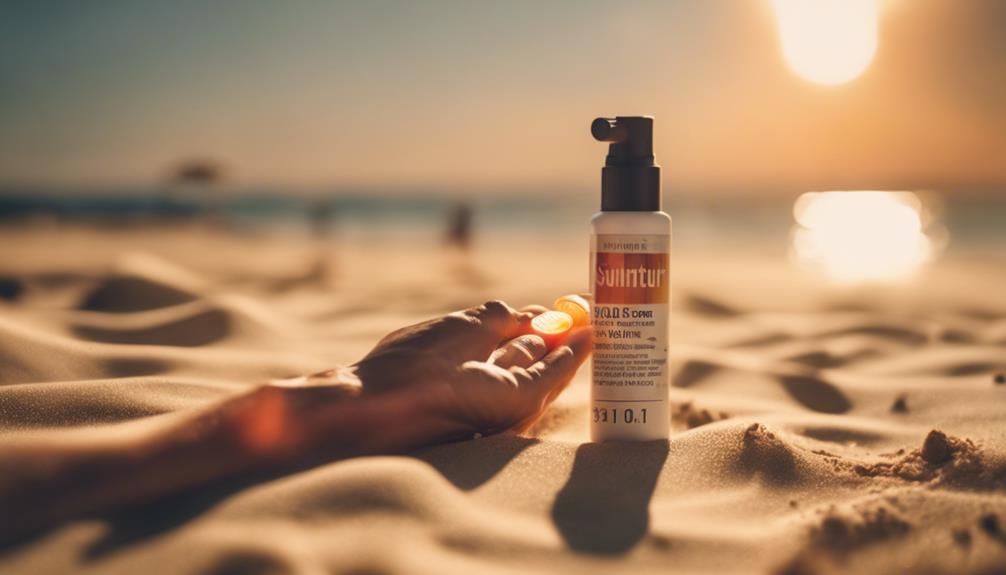
Overexposure to UV rays poses serious risks to your skin, increasing the likelihood of burns, premature aging, and even skin cancer. It's like playing with fire—sure, it might seem fun at first, but one wrong move and you're in trouble!
When you tan too much, your skin can become red and painful, reminding you that moderation is key. Plus, those fine lines and wrinkles? They'll pop up faster than you can say “sunburn.”
You might think you're winning the tan game, but overdoing it can lead to long-term damage. So, give your skin a break between sessions—after all, it's the only one you've got!
Keep it happy, and it'll thank you with a beautiful glow.
Essential Recovery Practices

Since recovery is essential for achieving a deeper, even tan, incorporating necessary practices into your regimen will help your skin heal and maintain its glow.
After tanning, give your skin a break—it's like a mini vacation! You don't want to rush things, right?
Exfoliate gently a day before your next session to keep that skin smooth and even.
Using tan extenders can be a game changer, too; they help your color last longer while keeping your skin feeling fabulous.
Don't forget to listen to your skin—if it's feeling a bit too crispy, it's time to take a breather.
Hydration for Healthy Skin

Hydration plays an essential role in maintaining healthy skin and enhancing your tanning results. When your skin's hydrated, it can better absorb UV rays and develop a beautiful, even tan. Imagine your skin as a sponge; if it's dry, it can't soak up that golden glow!
| Hydration Benefits | How to Stay Hydrated | Fun Fact |
|---|---|---|
| Softens skin | Drink plenty of water | Your skin is your largest organ! |
| Improves elasticity | Use a moisturizer | Water helps in getting a tan! |
| Enhances glow | Eat fruits and veggies | Hydrated skin fights sunburn! |
Long-term Tanning Strategies

Developing a long-term tanning strategy is essential for achieving and maintaining a healthy, vibrant glow while minimizing skin damage.
First, always listen to your skin; it's your best friend in this journey! Start with shorter sessions, especially if you're fair-skinned, and gradually increase the time as your skin adjusts.
Remember, spacing out your tanning sessions is vital—48 hours between sessions gives your skin time to recover and build melanin. In addition to spacing out your tanning sessions, it is important to always wear sunscreen with a high SPF to protect your skin from harmful UV rays. It is also beneficial to wear protective clothing, such as hats and cover-ups, while tanning. Following these skin protection tips will help prevent sunburn and long-term damage to your skin.
Also, don't forget to hydrate! A well-moisturized skin not only looks better but helps maintain your tan.
And hey, if you notice any redness or irritation, take a break! Your skin will thank you, and you'll be on your way to that stunning glow without all the stress.
Frequently Asked Questions
How Can I Tell if My Tan Is Fading?
You can tell your tan is fading if your skin appears lighter or patchy. Check for dryness or flakiness, as these signs indicate loss of color. Regular moisturization can help maintain your tan's vibrancy.
What Are the Best Products for Pre-Tanning Preparation?
For pre-tanning preparation, you'll want to exfoliate your skin, moisturize, and use a good tanning primer. These steps help achieve an even tan and enhance results, making your tanning experience more effective and enjoyable.
Can Dietary Changes Improve My Tanning Results?
Yes, dietary changes can improve your tanning results. Incorporating foods rich in antioxidants, vitamins A, C, and E, and staying hydrated will enhance your skin's health and melanin production, resulting in a more vibrant tan.
How Does Skin Type Influence Tanning Lotion Effectiveness?
Think of your skin type as a canvas; different lotions paint different results. If you've fair skin, lighter formulas may work better, while darker skin types benefit from richer, moisturizing lotions for ideal tanning effectiveness.
What Are the Signs of a Good Tanning Session?
A good tanning session leaves you with a golden glow, even color, and minimal redness. You should feel a slight warmth, not burning, and your skin should recover well, showing no signs of damage afterward.
Conclusion
So, there you have it! By spacing out your tanning sessions, you're not just chasing that sun-kissed glow; you're protecting your skin too.
Did you know that around 90% of skin aging comes from sun exposure? Yikes! That's a good reason to take it slow and let your skin recover.
Remember, a little patience goes a long way—your skin will thank you, and you'll be showing off a beautiful, even tan in no time!
Tanned Skin
Tanning Beds: Risks You Can't Ignore
On the path to a bronzed glow, uncover the shocking risks of tanning beds that could change your perspective on sun-kissed skin forever!

Tanning beds might look like a quick fix for a bronzed glow, but let's face it — they come with serious risks you can't ignore! Using them boosts your skin cancer risk by a jaw-dropping 75%, especially if you start young. It's not just about turning brown; those UVA rays also speed up wrinkles and skin damage. Plus, forgetting goggles can leave your eyes in a pinch! It's way safer to try self-tanners or professional sprays for that glowing look without the danger. Curious about the best ways to protect your skin? Keep on exploring for more tips!
Key Takeaways
- Tanning beds increase skin cancer risk by 75%, particularly for melanoma, with early exposure amplifying the danger.
- UV rays from tanning beds penetrate deeply, leading to premature aging, wrinkles, and skin damage.
- A 'base tan' offers minimal protection from UV rays and is not a safe alternative for sun exposure.
- Protective goggles are essential; tanning beds can cause significant eye damage without proper eye protection.
Health Risks of Tanning Beds
Using tanning beds greatly increases your risk of skin cancer, including melanoma, due to the harmful UV radiation they emit. On top of the skin cancer risk, tanning beds can also cause premature aging, wrinkles, and dark spots on the skin. Despite these risks, some people still believe in the benefits of tanning beds, such as getting a quick and easy tan, which can give them a healthy and attractive appearance. However, it is important to weigh these perceived benefits against the real and serious health risks associated with using tanning beds.
You might think a glowing tan looks great, but did you know that using tanning beds raises your risk of melanoma by a staggering 75%? That's like rolling the dice on your health every time you step in!
Early exposure to these rays, especially before you turn 20, can really up your risk. Plus, those sneaky UVA rays dive deeper into your skin, leading to wrinkles and other skin issues.
Usage Recommendations

To minimize skin damage and reduce the risk of skin cancer, limit your tanning bed sessions and follow safety guidelines carefully. You should aim for just a few sessions per month, especially if you have fair skin.
Always wear protective goggles—it's like giving your eyes a cozy blanket against harmful rays! Before tanning, check the equipment and make sure it's clean.
And remember, don't forget to consult a dermatologist for personalized advice; they're like your skin's best friend! If your skin feels red or tender, take a break; it's your body saying, “Hey, slow down!”
Safe Alternatives to Tanning
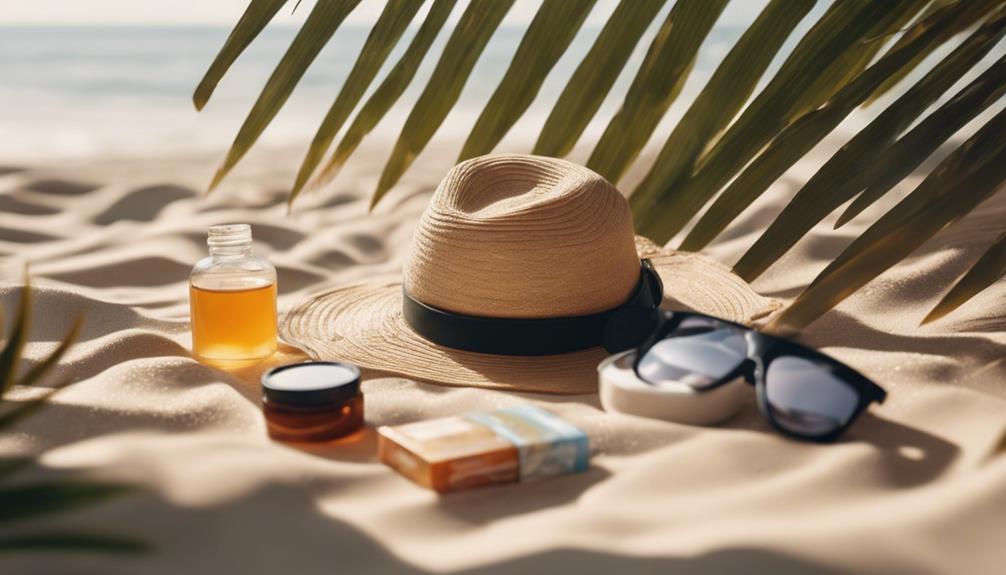
Self-tanning lotions and sprays offer a safe way to achieve that sun-kissed glow without the harmful effects of UV exposure.
You can easily apply these products at home, and they come in various shades, so you can find the perfect one for your skin tone.
Gradual tanners let you build your color slowly, which means you won't end up looking like a pumpkin!
Professional spray tans are also an option if you want that flawless finish without the DIY hassle.
Plus, bronzing makeup and body shimmer can give you an instant glow for special occasions.
With these fun alternatives, you can rock a radiant look while keeping your skin healthy and protected.
Say goodbye to tanning beds and hello to safe sunless tanning!
Skin Preparation Tips
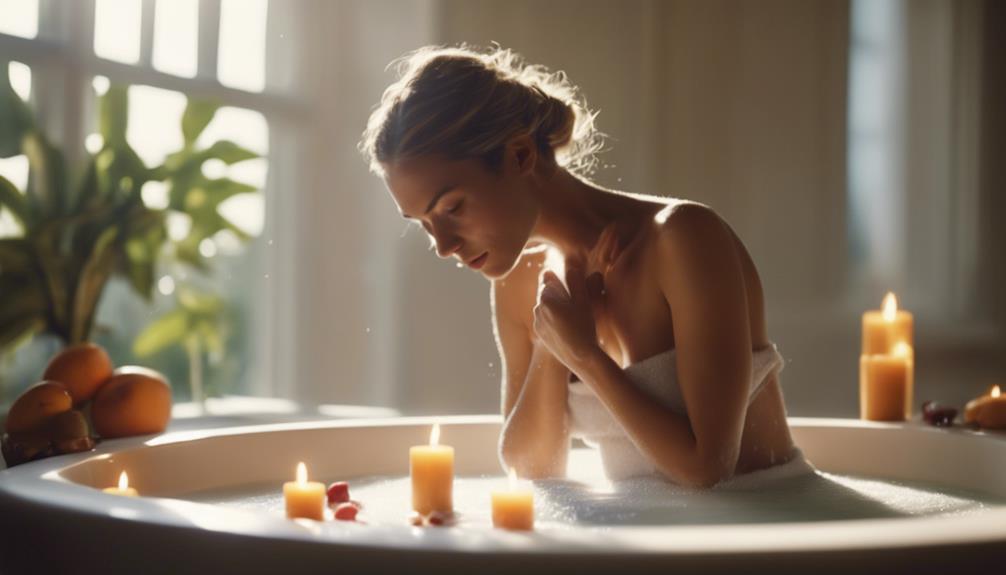
Exfoliating your skin 24 hours before tanning guarantees an even and smooth application for the best results. It's like giving your skin a fresh start! Make sure to moisturize afterward, too, as hydrated skin absorbs color better. Here's a quick guide to enhance your tanning prep:
| Step | What to Do | Why It Matters |
|---|---|---|
| Exfoliate | Use a gentle scrub | Removes dead skin, smooths texture |
| Moisturize | Apply lotion after exfoliating | Keeps skin hydrated, enhances color |
| Avoid alcohol/fragrance | Skip strong products | Prevents irritation and helps color stick |
Post-Tanning Skin Care

After tanning, proper skin care is essential to maintain your glow and keep your skin healthy.
First, hydrate your skin by applying a soothing lotion or aloe vera gel, which can help calm any redness and prevent peeling.
Remember, your skin just went through a mini vacation, so treat it well! Avoid hot showers and harsh soaps for a few days, as they can strip your skin of moisture. Instead, opt for gentle cleansers.
Don't forget to stay hydrated by drinking plenty of water, too! If you notice any irritation or unusual reactions, don't panic; just reach out to a dermatologist.
Your skin deserves the best post-tanning treatment, so give it the care it needs to shine!
Common Misconceptions

While you're taking care of your skin post-tanning, it's important to address some common misconceptions about tanning beds and their effects on your health.
First off, the idea of a “base tan” is pure myth! You can't protect your skin with a little pre-tanning.
Also, tanning beds aren't a magic source of vitamin D—sorry, sun worshippers! You might think you're getting a quick glow, but that's just leading to serious skin damage in the long run.
And don't rely on SPF alone; goggles are a must to protect your eyes.
Remember, the temporary thrill of a tan mightn't be worth the risks of melanoma and premature aging.
Understanding UV Radiation Effects

Understanding the effects of UV radiation is essential for making informed decisions about tanning and protecting your skin. You might think that a little tanning never hurt anyone, but the truth is, UV rays can cause some serious damage.
Here are four things you really need to know:
- Skin cancer risk: Using tanning beds can raise your risk of melanoma by a whopping 75%!
- Premature aging: Those UV rays speed up aging, giving you wrinkles and sunspots way too soon.
- Eye damage: Not wearing protective goggles? Your eyes could end up paying the price.
- Overexposure: Redness and peeling aren't just annoying; they're warning signs your skin's had enough.
Think twice before you hit the tanning bed! Your skin will thank you later.
Frequently Asked Questions
Can Tanning Beds Cause Immediate Skin Reactions?
Yes, tanning beds can cause immediate skin reactions. You might experience redness, tenderness, or peeling right after a session. It's crucial to monitor your skin closely and stop tanning if you notice any adverse effects.
How Often Should I Get Professional Skin Check-Ups?
Every now and then, you should get professional skin check-ups at least once a year. If you notice any changes or have concerns, don't hesitate to schedule an appointment sooner. Your skin deserves the best care!
What Are the Signs of Tanning Bed Addiction?
If you're noticing cravings for tanning, spending excessive time in beds, or feeling anxious when missing sessions, these might be signs of tanning bed addiction. It's important to recognize these behaviors and seek healthier alternatives.
Are There Any Safe Tanning Bed Brands?
There aren't truly safe tanning bed brands since all emit harmful UV radiation. Instead, consider safer alternatives like self-tanners or bronzers. Prioritize your skin's health and explore options that avoid UV exposure altogether.
How Do I Choose a Reputable Tanning Salon?
Choosing a reputable tanning salon is like finding a trusted chef; prioritize cleanliness, read reviews, check for FDA-approved equipment, and guarantee staff is knowledgeable. A good salon prioritizes your safety and delivers quality service.
Conclusion
So, before you jump into that tanning bed for a 'quick glow,' think about what you're really getting into. The risks are serious, and your skin deserves way better!
Instead of baking under harmful rays, why not try safer alternatives? Your quest for a sun-kissed look can still happen without the dangers lurking in those beds.
Remember, staying healthy and looking fabulous doesn't have to be a gamble—let's make choices that keep your skin glowing for years to come!
-

 Vetted3 months ago
Vetted3 months ago15 Best Tanning Accelerators for a Sun-Kissed Glow This Summer
-
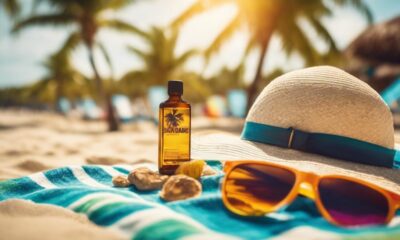
 Vetted3 months ago
Vetted3 months ago15 Best Tanning Oils for a Perfect Sun-Kissed Glow in 2024
-

 Vetted3 months ago
Vetted3 months ago15 Best Sun Tanning Products for a Gorgeous Glow This Summer
-

 Sun Protection3 months ago
Sun Protection3 months agoHow to Protect Your Skin Without Staying Indoors All Day
-

 Sun Protection3 months ago
Sun Protection3 months ago10 Sun Protection Myths Debunked!
-
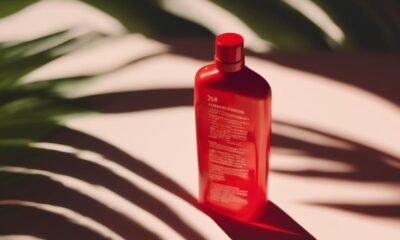
 Sun Protection3 months ago
Sun Protection3 months agoWhat Dermatologists Wish You Knew About Sunburns
-

 Sun Protection3 months ago
Sun Protection3 months agoThe Best Sun Protection Routine for Your Skin Type
-

 Vetted3 months ago
Vetted3 months ago15 Best Tanning Routines for Achieving a Sun-Kissed Glow Safely










